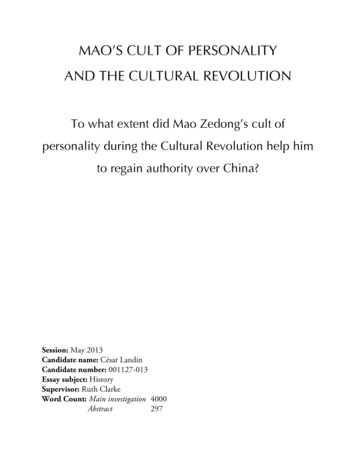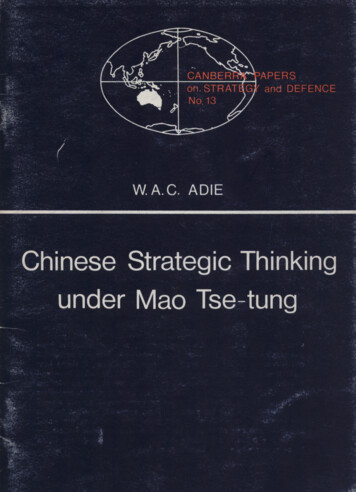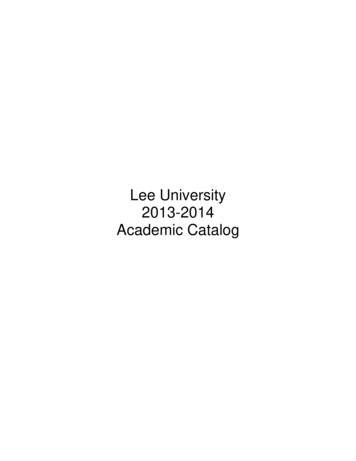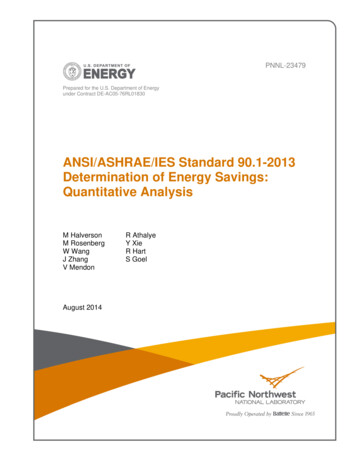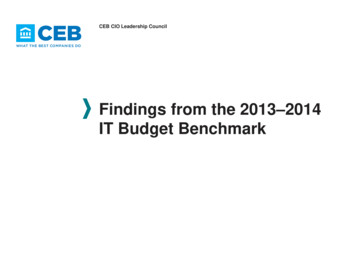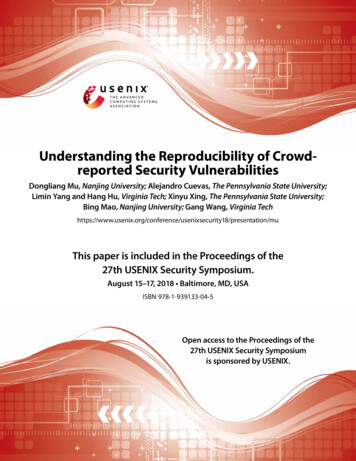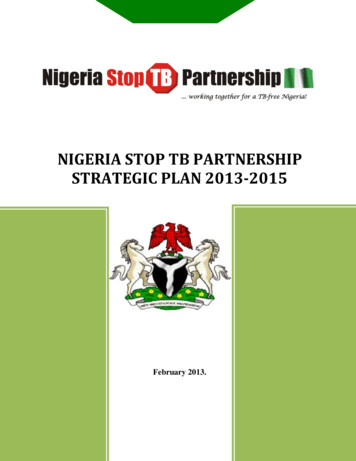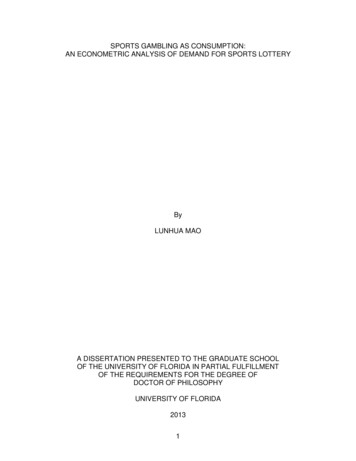
Transcription
SPORTS GAMBLING AS CONSUMPTION:AN ECONOMETRIC ANALYSIS OF DEMAND FOR SPORTS LOTTERYByLUNHUA MAOA DISSERTATION PRESENTED TO THE GRADUATE SCHOOLOF THE UNIVERSITY OF FLORIDA IN PARTIAL FULFILLMENTOF THE REQUIREMENTS FOR THE DEGREE OFDOCTOR OF PHILOSOPHYUNIVERSITY OF FLORIDA20131
2013 Lunhua Mao2
To my family and friends for their unwavering support and encouragement over theyears3
ACKNOWLEDGMENTSI would never have been able to finish my dissertation without the guidance of mycommittee members, help from friends, and support from my family and wife.I would like to express my deepest gratitude to my mentor, Dr. James Zhang, forhis excellent guidance, caring, patience and support during the past four years, and forinvesting much time, effort and interest in this research project. I would also like to thankDr. Dan Connaughton for his willingness to chair my committee after Dr. Zhang movedto the University of Georgia, for his advice, encouragement, and support over the years.I am fortunate to have these two advisors in my life and am truly indebted for theirguidance.I would like to give special thanks to Dr. Steven Shugan, who was more thangenerous with his expertise and precious time. I benefited tremendously from hisinspiring writings, lectures and comments. I am also grateful to my other committeemembers, Dr. Stephen Holland, Dr. J. O. Spengler, and Dr. Beth Cianfrone, forproviding numerous hours of advice and critiques.I would like to thank Dr. Hai Li at the Shanghai University of Sport for providingme some valuable research materials. I would like to thank my friends and fellowdoctoral students at UF for their support, feedback, and friendship. Finally, I thank myparents, my sisters, and my wife for their love and continuing support.4
TABLE OF CONTENTSpageACKNOWLEDGMENTS . 4LIST OF TABLES . 8LIST OF FIGURES . 9LIST OF ABBREVIATIONS . 10ABSTRACT . 11CHAPTER1INTRODUCTION . 13Significance of Sports Gambling Industry . 13Need for Empirical Demand Research. 15Statement of Problem . 18Purpose of the Study . 22Significance of the Study . 22Delimitations of the Study . 23Definition of Terms . 242REVIEW OF LITERATURE . 26Gambling, Lottery, and Sport . 26Gambling . 26Lottery . 28Sports Gambling . 32Lottery Gambling in China . 36Theory of Demand and Utility of Lottery Gambling . 40Expected Utility Theory and its Generalizations . 41Indivisibility in Expenditure Hypothesis . 43Consumption Utility Hypotheses. 47Determinants of Lottery Demand . 51Product Attributes and Demand . 51Effective price . 51Jackpot size . 55Estimation problems . 58Game attractiveness . 61Consumer Characteristics and Demand . 61Income . 61Age . 65Education . 665
Gender . 68Religion . 68Ethnicity . 69Marketing Variables and Demand . 70Border competition . 70Product substitution . 72Venue accessibility . 74Social responsibility marketing . 75Summary . 763METHOD . 78Background about Shengfu game . 78Econometric Framework . 81Decision Calculus . 81Prize Pool . 82Risk of Prize Sharing . 83Expected Prizes . 85Relationships between Expected Value and its Determinants. 85Empirical Models . 86Time Series Analysis . 86Derivation of effective price . 87Derivation of prediction difficulty coefficient . 87Derivation of ticket composition variables . 88Marketing and game feature dummies . 90Panel Data Analysis . 90Population and population compositions . 90Derivation of the income variable . 91Derivation of the sport variable . 91Venue accessibility . 92Method of estimation . 924RESULTS . 103Results of Time Series Analysis . 103Stationarity, Autocorrelation, and Dynamic Specification . 105Ordinal Least Squares Results . 107Instrumental Variables Results . 110Using CAP as Instrument . 111Results of Panel Data Analysis . 113Pooled Models. 113Fixed Effects Models . 114Two-Way Random-Effects Models . 115Instrumental Variables Results . 1165DISCUSSION . 1316
Theoretical Contributions . 132Sports Lottery as Consumption . 132Rationality in Sports Gambling . 134Impact of Social Demographics . 135Impact of Marketing and Structural Changes of the Game . 136Consumer Learning or Consumer Attrition . 139Dynamic Nature of Sports Gambling Behavior . 139Managerial Implications . 140Limitations and Future Directions . 142Conclusion . 143APPENDIX: SUPPORTING INFORMATION FOR CHAPTER 3 . 147LIST OF REFERENCES . 148BIOGRAPHICAL SKETCH . 1607
LIST OF TABLESTablepage2-1A comparison of CWLDMC and CSLAC lottery products in China . 773-1Historical changes of the Shengfu game design. 973-2Description of variables included in time series analyses . 983-3Coding the combination of the matches . 1003-4Description of variables included in panel data analyses . 1013-5Descriptive statistics and factor solution for deriving SPORT variable . 1024-1Descriptive statistics for time series data . 1184-2Results of time series regressions . 1244-3Descriptive statistics for the panel data analysis . 1284-4Results of panel data regressions . 1295-1Prediction difficulty coefficients by ticket compositions . 1455-2Sales comparison between two simultaneous draws . 1468
LIST OF FIGURESFigurepage3-1Relationships among sales, expected value, and market-level skill coefficient . 953-2Time series line of sales of Shengfu game over 2001-2012 . 963-3Distribution of Prediction Difficulty Coefficient as measured by log(RATIO2) . 994-1Historical change of market-level skill coefficients (λ1, λ2) . 1194-2Impact of rollover on demand . 1204-3Impact of ticket composition and rollover on demand: Using four mostpopular leagues as an example . 1214-4ACF-PACF of sales and residuals of its AR(2) model . 1224-5ACF-PACF of log(Sales) and residuals of its AR(4) Model . 1234-6Within and between variations in panel data . 1264-7Separate simple regressions of 30 provinces: sales on effective price . 1279
LIST OF ABBREVIATIONSCSLACChina Sports Lottery Administration CenterCWLDMCChina Welfare Lottery Distribution & Management CenterGBGCGlobal Betting and Gaming ConsultantsGGYGlobal Gambling Yield, gross bets minus winnings paymentsNGISCNational Gambling Impact Study CommissionPASPAProfessional and Amateur Sports Protection Act of 1992UKNLUnited Kingdom National Lottery10
Abstract of Dissertation Presented to the Graduate Schoolof the University of Florida in Partial Fulfillment of theRequirements for the Degree of Doctor of PhilosophySPORTS GAMBLING AS CONSUMPTION:AN ECONOMETRIC ANALYSIS OF DEMAND FOR SPORTS LOTTERYByLunhua MaoAugust 2013Chair: Daniel P. ConnaughtonMajor: Health and Human PerformanceDespite that sports lottery gambling has become a prevalent economic andrecreational activity, it remains an under-researched area in sports managementliterature. Based on Conlisk’s (1993) theory on the utility of gambling, an econometricmodel of demand for sports lottery gambling was constructed and examined in thisstudy. The model assumes an experiential utility associated with sports lotterygambling, and proposes that rational consumers are mainly motivated by three clustersof variables: product attributes, consumer demographics, and marketing variables. Themodel is empirically examined by using a set of draw-to-draw sales data (from 2001 toAugust 2012) of the Shengfu game, the most representative sports lottery in China.Through time-series and panel data analyses, this study has the following majorfindings: (a) sports lottery has consumption value for players, for which ticketcomposition has considerable impact on the demand. Draws composed of popularleagues and tournaments are often associated with higher demand; whereas, drawscomposed of smaller leagues often sell less; (b) consumers are sensitive to the implicitcost of a buying lottery ticket (i.e., effective price), where the estimated effective price11
elasticity is around -1; (c) at least in the context of Chinese sports betting market, theprovince with higher income level had higher demand for sports lottery, contradicting theregressivity property of traditional lottery games. The estimated income elasticity isaround 0.4; (d) consistent the research findings of previous studies, populationsegments with higher financial and social burdens tends to buy more lottery tickets; (e)marketing variables and structural arrangements of the game were found havesignificant impact on consumer demand of sports lottery tickets; (f) consumers showedsigns of learning from betting experience and increasing the odds of winning asevidenced by an ever increasing median probability of winning the first and secondprizes; and (g) population, education level, sport development, and venue accessibilitywere found not significantly related to the demand of sports lottery.12
CHAPTER 1INTRODUCTIONSignificance of Sports Gambling IndustryThe next best thing to a fortune is the chance of a fortune To purchase aticket in a lottery, indeed, is to buy a kind of fiction in which oneself is thehero.– Chance, New Statesman and Nation, June 6, 1931.Both gambling and sports are ancient and ubiquitous. People flock to casinos,horse tracks, and betting shops. People play and spectate sports in droves. Themagnitude of dollars involved in gambling is staggering - 2.6 trillion U.S. dollars werespent in 2007 worldwide (Morss, 2012). The forms of legal gambling are various,including lotteries, bingo, casino, and sports gambling. Most Americans haveparticipated in some form of gambling whether it involves purchasing a lottery ticket,playing fruit machine, placing a bet at the track, or making a bet with friends in an officepool (Welte, Barnes, Wieczorek, Tidwell, & Parker, 2002). As staggering is people’spassion about sports; for instance, the top four professional leagues in North America,National Football League (NFL), National Basketball Association (NBA), NationalHockey League (NHL) and Major League Baseball (MLB), collectively bring in about 24billion U.S. dollars in revenue during a typical year, which is just the tip of the iceberg.The estimated sport business scale in the United States alone is worth between 400 to435 billion U.S. dollars (Plunkett Research, 2012).What ties gambling and sports together is that people like betting on the outcomeof sporting events. Apart from forerunners in ancient Rome and Greece, organized andsanctioned sports betting dates back to the late 18th century, when modern bookmakingand pari-mutuel systems came into being (Munting, 1996). Today, the proliferation of13
modern technology in the sport arena has further contributed to the growth of gamblingparticipation (Claussen & Miller, 2001). Although representing only 2.6% of the legalizedgambling market, sports gambling has become the fastest growing gambling segment,with an annual growth rate of 14.7% in the past five years (AAP News, 2012). Forinstance, in the United States where bookmaking is only legal in Nevada and certainforms of sports lotteries in Oregon, Delaware, and Montana, sports gambling represents9.86% of the sports industry (Zhang & Cianfrone, 2011). In 2011, 2.88 billion U.S.dollars were legally waged in Nevada’s sports books, representing less than 1% of allsports betting in U.S. Approximately 93.9 million was wagered on the Super Bowl inthe state’s sports books in 2012 according to the Nevada Gaming Control Board, andthe event earned a net income of 5.1 million for the Nevada sports books (AmericanGaming Association, 2012). During the 2010–2011 fiscal year, the British gamblingindustry generated a gross yield of 5.5 billion, where the sports betting sector had thelargest market share within the sports industry, accounting for 53% of all gamblingtransactions (Gambling Commision, 2012).Regardless of its relatively short appearance in the world gambling and sportbusiness milieu, China has achieved rapid developments in both industries. Theaverage annual growth rate of the sport industry has been about 20% or higher inrecent years. In 2008, the sports industry realized a total transaction value of 22.87billion, accounting for 0.52% of China’s total GDP (Li et al., 2012). The last two decadesalso witnessed a gradual open-up of China’s gambling market. Yet, the only legal formof gambling in China remains national lotteries, which are administered by two nationalagencies: China Welfare Lottery Distribution and Management Center (中国福利彩票发14
行管理中心, CWLDMC) and China Sports Lottery Administration Center (中国体育彩票管理中心, CSLAC). Since the inception of the first national lottery in 1987, the lotterygambling market has been growing rapidly in the past 25 years. The entire marketreached to 221.6 billion yuan (about 35.1 billion U.S. dollars) in 2011, representing a33.3% annual growth. The sales of CWLDMC lottery reached127.8 billion yuan, makinga net revenue of 39 billion yuan; and the sales of CSLAC lottery reached 93.8 billionyuan, making a net revenue of 25.3 billion yuan (Ministry of Finance, 2012). Almost allmainstream lottery schemes, including lotto, numbers game, instant games, and highfrequency lotteries are now administered by both centers, however the sports lottery areonly available from the CSLAC. Sports lottery provides a niche market for the CSLAC.In 2011, the sales of the sports lottery climbed to about 21.8 billion yuan, representing23% of the CSLAC lottery market and 10% of China’s lottery market (Ministry ofFinance, 2012). China’s sports lottery, however, is not an entire innovation. Itscounterparts can be found in other countries, such as the Sports Select in Canada, LaQuiniela in Spain, Football Pool in UK, and the Delaware sports lottery in the U.S.Need for Empirical Demand ResearchThe burgeoning of the gambling and lottery industry is puzzling. Gambling is azero-sum game. Gambling market in general cannot simultaneously yield profits for bothsides of gambling participants (Sauer, 1998). Lottery market is even worse. With ahigher take-out ratio compared to other forms of gambling and an extremely lowprobability of wining, the average expected return on one dollar lottery ticket is between40 and 60 cents (Thaler & Ziemba, 1988). Lottery tickets are evidently a type of“negative asset”, and usually a poor investment for any rational economic agent whose15
goal is to maximize their expectation of return. Yet, people continue to buy lotteries, indroves anyway, violating the standard economic assumption of rationality and riskaversion in human behavior (McCaffery, 1994; Quiggin, 1991). Furthermore, thecoexistence of gambling and insurance purchase constitutes a paradoxicalphenomenon that has attracted much scholarly interest. Scholars working in theseparate disciplines of psychology, economics, sociology, and among others haveexplored the phenomenon. This has led to two broad categories of explanation: rationalvs. irrational. The stream of rationality of playing lottery has focused on the consumptionvalue of lottery play (Conlisk, 1993; Forrest, Simmons, & Chesters, 2002), lottery playas motivated by indivisibility in expenditures (McCaffery, 1994; Ng, 1965), and lotteryplay as a means to gain “something for nothing” (Nyman, Welte, & Dowd, 2008). Thestream of irrationality has largely drawn on the Prospect Theory (Kahneman & Tversky,1979) and cognitive theories of gambling (Rogers, 1998), maintaining that lottery play isout of ignorance or cognitive error of the players.Nevertheless, empirical investigations of the demand for lottery products in theeconomics literature explicitly or implicitly adopt a paradigm based on the expectedutility theory. They have examined the demand for lottery products empirically fromeither of two perspectives: a source of public revenue or a consumer commodity(Clotfelter & Cook, 1990). Since public lotteries were introduced as a way to increasegovernments’ budgetary income, and the takeout of lottery revenues can be regardedas an implicit tax levied on the players, a line of research examines the economic andsocial implications. The main empirical questions arising from this perspective are theestimation of income elasticity of demand (i.e., whether this lottery tax is progressive,16
neutral, or regressive) to assess the impact of lottery tax on the relative distribution ofincome among the population (Clotfelter, 1979; Garrett & Coughlin, 2009; Ghent &Grant, 2010; Spiro, 1974), and the estimation of own-price elasticity of demand toassess whether the price or takeout rate is optimal to maximize revenue (DeBoer, 1986;Forrest, Gulley, & Simmons, 2000; Gulley & Scott, 1993). The main empirical questionsarising from the later perspective are whether consumer demand for lottery gamesresponds to true expected returns, as maximizing behavior predicts, or whetherconsumers seem to be misinformed about the risks and returns of lottery game, andwhat factors to be included in the estimable demand functions. These works may bedivided into those who used product attribute variables, such as effective price, jackpot,and prize structure (Forrest et al., 2002; García & Rodríguez, 2007; Scoggins, 1995),those who used consumer characteristic variables, such as income, gender, age,education, religion, and ethnicity (Felsher, Derevensky, & Gupta, 2003; Herring &Bledsoe, 1994; Walker, Courneya, & Deng, 2006), and those who used marketingvariables, such as venue accessibility (Hing & Haw, 2009), cross border competition,and product substitution (Forrest, Gulley, & Simmons, 2004; Garrett & Marsh, 2002),and social responsibility marketing (Li, Zhang, Mao, & Min, 2011).The purpose of demand analysis is to explain the process by which a consumermakes choices to maximize the utility he or she can derive from selecting the bestpossible combination of commodities within the budget constraint (Clarkson, 1963).Traditional demand analysis starts with an underlying utility function. Whereas utilityitself involves no psychological interpretation, it is supposed to describe consumer’spreferences and rationalizes that demand behavior (Varian, 1992). The theory of17
demand evolves with the debates centering the fundamental assumption of rationality inhuman behavior, and has been gradually given much behavioral interpretation (Becker,1962; Domencich, McFadden, & Charles River Associates., 1975; Zhang, Lam, &Connaughton, 2003a; Zhang, Lam, Williamson, Braunstein, & Ellis, 2003c). Marketdemand is regarded as consumer expectations towards the main attributes of the coreproduct (Zhang et al., 2006; Zhang, Lam, & Connaughton, 2003b). Demand analysis interms of product features, consumer characteristics, and marketing environment isessential to develop a product that can deliver values to the consumers; demandanalysis in terms of consumer characteristics is fundamental to segment consumers;demand analysis in terms of marketing variables can facilitate the formulation ofmarketing plans and forecast of sales (Kotler & Keller, 2009). In lottery gamblingliterature, the insights from demand studies thus far have been consequential. Theextant evidence suggests that lottery participation rates and levels of lottery purchasesare strongly influenced by the effective price and the jackpot. Furthermore, the resultsfrom previous studies indicate that the heaviest lottery players are poor, young, anduneducated single men who live in urban areas and belong to specific minority (AfricanAmerican and Hispanic) and/or religious (Catholic) groups.Statement of ProblemThere is apparent paucity in research on sports lottery gambling. Conceptual andempirical investigation of this topic has been limited to a very small number of studies,for example, Forrest and Simmons (2003) made a case of the symbiotic relationshipbetween gambling and sport; Smith (1992) documented the development of sportslottery in Canada; Claussen and Miller (2001) made a conceptual arguments about thedriving forces of sports gambling in the U.S.; and García and Rodríguez (2007) and18
García, Pérez, and Rodríguez (2008) tested the demand for football pools in Spain.There is thus far a wide gap between theory and practice with regard to sports lottery.Sports lottery comes into being as a compromise between traditional lotterygames and sports betting. Arguably a form of lottery, sports lottery differs fromtraditional games in several critical aspects. The first difference is in the nonrandomness of the drawing. All traditional lotteries that share the characteristic ofrandom selection of winners without any intellectual factor, such as skill and knowledge,associated with picking a winning ticket (Mikesell & Zorn, 1987). In contrast, sportslottery has no well-defined objective probability of winning. Information and knowledgeplayers have about the sport teams, such as competition records, competence of thecoach, and performance of the players, may influence one’s winning probability. It hasbeen shown that the probability of winning a grand prize by correctly forecasting thecompletion results of all matches in the parlay is much higher than the probability if thecompetition results were completely random (García & Rodríguez, 2007). It is exactlybecause of its non-randomness in determining a winner, the Football Pool in the UK isnot regarded as a component of its national lottery system (Munting, 1996). The seconddifference is in knowledge-based reasoning and over-confidence. Relating to the natureof sports gambling, players tend to rely more on their background knowledge of thesport than evaluation of risk dimensions (e.g., probability of winning and pay-out rate) intheir lottery ticket purchasing decision (Ranyard & Charlton, 2006). Moreover, sportsfans often consider themselves as experts. Due to simplistic nature of various sportcompetition forms along with their familiarity and interest of sports, sport gamblers oftenfeel they have superior expertise and intelligence in beating the prediction odds. This19
over confidence would likely carry over to their lottery purchase decision, and may alsoinduce stronger wishful thinking than what has been found in traditional lottery games.The third difference is related to the experiential utility in sports gambling. Sportingevents are emotionally charged and the final result of a game means much to a reals
pool (Welte, Barnes, Wieczorek, Tidwell, & Parker, 2002). As staggering is people's passion about sports; for instance, the top four professional leagues in North America, National Football League (NFL), National Basketball Association (NBA), National Hockey League (NHL) and Major League Baseball (MLB), collectively bring in about 24

